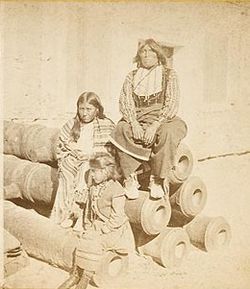Buffalo Hunters' War
| Buffalo Hunter's War | |||||||
|---|---|---|---|---|---|---|---|
| Part of the Texas–Indian wars, Apache Wars | |||||||
 Black Horse with his wife and child at Fort Marion, Florida. | |||||||
| |||||||
| Commanders and leaders | |||||||
| Hank Campbell - Buffalo hunters | Black Horse - Comanche | ||||||
- v
- t
- e
- Comanche Wars
- Fort Parker
- Stone Houses
- Arroyo Seco Fight
- Killough
- San Gabriels
- The Neches
- Council House Fight
- Great Raid
- Plum Creek
- Village Creek
- Bandera Pass
- Muncey
- Apache Wars
- Jicarilla War
- Diablo Mountains
- Devil's River
- Antelope Hills
- Little Robe Creek
- Pease River
- 1st Adobe Walls
- Comanche Campaign
- Red River War
- Warren Raid
- Blanco Canyon
- North Fork of the Red River
- 2nd Adobe Walls
- Palo Duro Canyon
- Buffalo Hunters' War
- Staked Plains Horror
- Yellow House Canyon
The Buffalo Hunters' War, or the Staked Plains War, occurred in 1877. Approximately 170 Comanche warriors and their families led by Quohadi chief Black Horse or Tu-ukumah (unknown–ca. 1900) left the Indian Territory in December, 1876, for the Llano Estacado of Texas. In February, 1877, they, and their Apache allies, began attacking buffalo hunters' camps in the Red River country of the Texas Panhandle, killing or wounding several. They also stole horses from the camp of Pat Garrett.[citation needed]
Forty-five hunters, led by Hank Campbell, Jim Smith, and Joe Freed, and guided by Jose Tafoya, left Rath City, a trading post on the Double Mountain Fork Brazos River. Smoky Hill Thompson remained behind to lead the defense of the trading post.[citation needed]
The party trailed the natives to their camp in Thompson's Canyon, now known as Yellow House Canyon in present-day Lubbock, Texas, where they attacked on March 18. The hunters were repulsed and the natives escaped, including white captive Herman Lehmann, who was wounded in the battle.[citation needed]
The hunters' casualties were four wounded and one later dying from wounds. It was later reported by the military that the natives suffered 35 dead and 22 wounded.[citation needed]
See also
References
- Dictionary of American History by James Truslow Adams, New York: Charles Scribner's Sons, 1940
- The Border and the Buffalo by John R. Cook, 1907, Citadel Press (1967)
- Black Horse from the Handbook of Texas Online
- Battle of Yellow House Canyon from the Handbook of Texas Online
- In 1877, Mackenzie Park was site of a deadly battle. Lubbock Online, Nov. 27, 2007
 | This Oklahoma-related article is a stub. You can help Wikipedia by expanding it. |
- v
- t
- e
 | This Texas-related article is a stub. You can help Wikipedia by expanding it. |
- v
- t
- e
 | This hunting-related article is a stub. You can help Wikipedia by expanding it. |
- v
- t
- e












